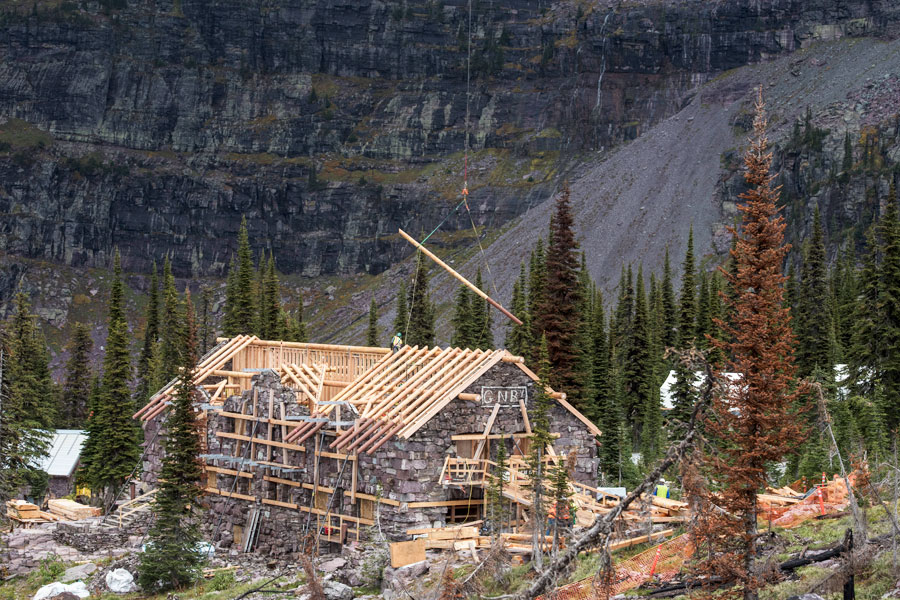Immediately after the 2017 Sprague Fire reduced the 106-year-old Sperry Chalet in Glacier National Park from an iconic backcountry destination to a smoldering ruin, the ambitious race to rebuild the historic structure began in earnest.
“Rebuilding Sperry Chalet is definitely a once-in-a-lifetime experience, and the partner engagement has been remarkable,” Glacier National Park Superintendent Jeff Mow said, adding that he received a call from the Glacier National Park Conservancy, the park’s fundraising partner, the morning after the chalet was overrun by wildfire.
Donations began pouring in to the Conservancy’s coffers, with contributions coming from citizens of every state in the U.S. and nine other countries.
Soon after Sperry Chalet was lost on Aug. 31, 2017 after the 17,000-acre wildfire doubled in size in a matter of hours, destroying its fir-and-lodgepole framework and leaving behind only the native-rock shell hewed from a nearby mountain quarry by Italian stone masons more than a century ago, former Secretary of Interior Ryan Zinke announced that he wanted the historic wilderness chalet to be rebuilt as quickly as possible. That fall, Glacier employees conducted emergency stabilization work to ensure that the remaining stonewalls would survive the winter.
“We literally took a credit card to a hardware store in Columbia Falls and bought the timber to brace the stone masonry,” Glacier National Park Conservancy Executive Director Doug Mitchell said. “We were going to build history that day.”
With the timber braces in place, a heavy winter converged in northwest Montana, and no one knew whether Sperry would survive the weather buffeting its stone walls perched in the mountains high above the Lake McDonald, or whether it would collapse under the weight of winter.
Adele Scholl, of the aerial photography company Gravity Shots, helped ease the anxiety surrounding Sperry’s survival when she photographed the structure during a flyover on a rare sunny day that winter. The walls were intact.
“We were all quite nervous,” Scholl said.
The National Park Service streamlined the permitting process for rebuilding the chalet and in June 2018 announced that it would spend $12 million reconstructing Sperry over the next two years. Mitchell’s group raised more than $600,000, and hopes to raise another $500,000 to cover non-construction costs, like matching historic fixtures.
Starting in July, laborers with Dick Anderson Construction of Great Falls began additional stabilization work at the chalet and the installation of new concrete footings. Once those projects were out of the way, they began to construct the first and second floors and a roof, with a September deadline to complete the project’s first phase.
While crews hiked into the remote work site, materials were brought in by helicopter. By August, two rotating work crews of seven to eight people would hike in and work for eight days before hiking back out for six days off. The Sperry project posed a number of challenges.
Foreseeing the monumental task at hand, Mitchell hired a photographer, Amy Boring, to document the crew’s progress. She earned their trust and embedded herself in the remaking of history.
On Feb. 13, during an open house celebration of the rebuilding effort, which followed an industry night for construction contractors interested in bidding on the second and final phase of the Sperry project this summer, Boring shared a slideshow she compiled of images showing the work from July until September.
It culminates in a series of photos of the construction of the roof, the completion of which marked a significant milestone for the hard-working crew members.
“That was an amazing day,” Boring said. “Spirits were so high. There was such as sense of accomplishment. It really became like a family over time.”
Using materials that match the historic style of the chalet, they also include some code upgrades. The beams used to construct the roof, for example, are fortified with steel rods, and the fire-impregnated wooden shingles include a Class A fiberglass capsheet, according to Liz Hallas, of Hallas and Anderson Architects.
“What these guys and gals accomplished in just a short amount of time is just stunning,” Mitchell said. “You’re never going to have the experience again of seeing Sperry under construction.”
“This is about continuing the Sperry experience for the next 100 years,” he added.
Sperry Chalet concessioner Kevin Warrington, whose grandparents became Sperry’s first concessioners in 1954 when they began offering rooms, hot meals and lemonade to the park’s visitors, described the last time he saw the chalet intact in August 2017, having just finished a major maintenance project.
“We had even put brand new bedding on the beds just three days before the fire,” he said.
Pondering the question “what is a chalet?” Warrington said he disagrees with the literal definition that characterizes a chalet as simply a herdsman’s hut in the alps.
“A chalet has style. It has elegance and it has class,” he said. “One of the defining characteristics of a chalet is that it is stylish.”
After the main two-story dormitory was destroyed in the Sprague Fire (a number of outbuildings were saved, including the stone kitchen, dining room, and a state-of-the-art outhouse with four composting toilets) Warrington visited the remains.
“I didn’t see a chalet. I saw a ruin,” he said. “I was not comfortable being around that building. It was not a pleasant experience.”
Throughout the rebuilding effort, however, Warrington witnessed a gradual transformation.
“Then there was a magical day when I walked in there and there were beams on the roof, and all of a sudden it felt good to be in that building again,” Warrington said. “It was no longer a ruin.”
